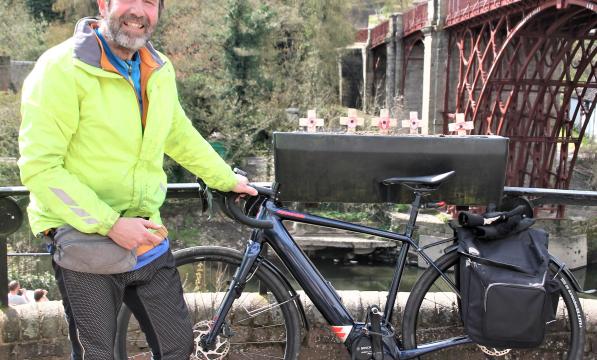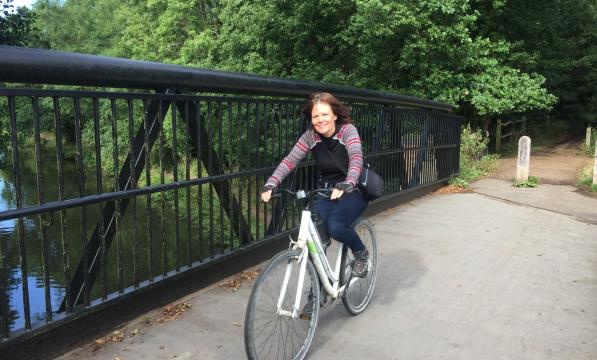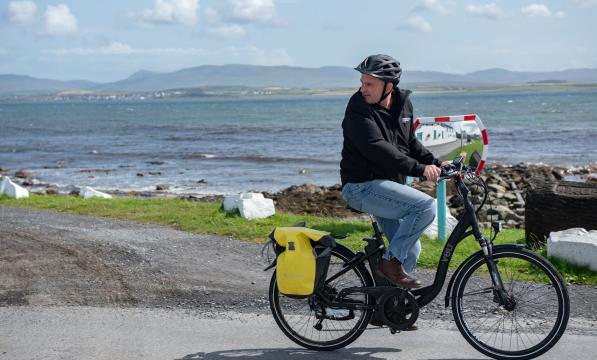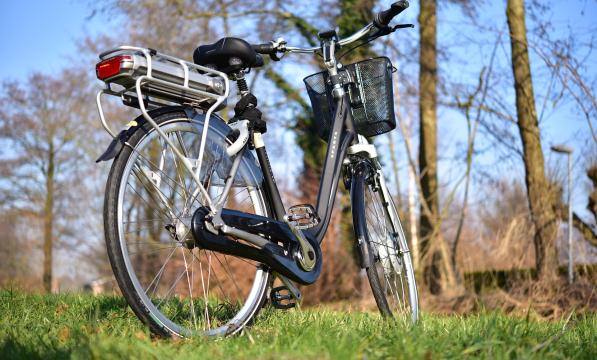Electric cycles and the law: what you need to know
When is an e-cycle not an e-cycle?
E-cycles are classed as regular non-assisted cycles in Great Britain. However, if they supply electrical assistance when travelling at more than 25kph (15.5mph), have a motor which generates more than 250 Watts of power or motor assistance can be provided without the bike's pedals being in motion, they will be legally treated as a moped or motorcycle. These powered two-wheelers are subject to a different regulatory framework.
So because it is considered to be a bicycle, I don’t need a driving licence?
As long as your electric bike complies with the restriction listed above, that is right. You can ride on roads, cycle paths and other places where bicycles are allowed under GB law. You don’t need to register the bike as you would a motor vehicle, including mopeds and motorbikes, or have insurance or wear a helmet.
One more thing, the law states you must be 14 years of age or over to ride an e-bike on public roads. However, someone under 14 can ride an e-bike off road. Sixteen years is the minimum age to ride a moped in the UK, but this was reduced to 14 years for e-bikes, taking into account their lower levels of power.
What if my e-bike doesn’t meet the regulations?
If you want to use it on a public highway, you will need to register the e-bike with the DVLA, plus you’ll need a driving licence, insurance and to wear a helmet like you would on a motorbike or moped. More information on the regulations are explained in Is your e-bike legal? Electrically assisted pedal cycles regulations.
Does this make any e-bike that doesn’t comply with the restrictions illegal?
It’s not illegal to own an e-bike with a power output exceeding 250 Watts, or where the electrical assistance doesn’t cut off at 25kph. However, it is illegal to ride it as you would a standard bike (without it being registered and insured like a moped), on a public highway – this includes both roads and off-road rights of way such as bridleways and byways.
Unregistered and uninsured e-bikes that do not conform to regulations can only be ridden on private land where the public doesn’t have access, with the permission of the landowner.
What is the position in Northern Ireland?
The legal position is the same in Northern Ireland as the rest of the UK. In May, the Northern Ireland Assembly passed the Electrically Assisted Pedal Cycles (Construction and Use) Regulations (Northern Ireland) 2020 which updated an outdated law. While the Assembly had not been sitting an opportunity to bring the law into line with other nations had been missed.
Is there a separate law for ‘twist-and-go’ e-bikes?
Some e-bikes don’t need to have their pedals in motion for the motor to be engaged. Some manufacturers produce bikes controlled by a throttle, which can be twisted to start, without pedalling, hence the name ‘twist-and-go’ machines.
New models of this kind are now classified under EU law under the L1e-A ‘powered cycles’ category which allows power up to 1,000 Watts. This means that they are not classed and regulated as conventional cycles, but the exact requirement for registering them in the UK remain unclear.
The legal position is further complicated because ‘twist-and-go’ e-bikes bought before the introduction of the new laws and limited to a 250 Watt motor remain effectively legal and can be bought second hand.
How easy is it to tell if an e-bike falls foul of the regulations or not?
In practice most new e-bikes in the UK are built for the European market and so comply with European standard; look for the CE conformity mark to confirm the product has passed the relevant tests.
Looking at the shape and size of a bike won’t tell a purchaser all its specifications, but Construction and Use regulations define the legal safety criteria for bikes.
The most relevant of these for electric bikes is that they should be fitted with a sticker or plate showing the manufacturer’s name and the power output must default to the off setting so there is no power assistance without pedalling.

Are an e-bike and a Pedelec one and the same?
They are, but the s-pedelec or speed pedelec is the name given to machines that have greater speed capacity than a standard pedelec; while not common in the UK, these are increasingly popular in Germany and Holland. Machines that exceed the 25kph assistance limit are generally known as speed-pedelecs or s-pedelecs.
They cannot travel faster than 45kph or 28mph and the EU regulations require users to possess a moped driver’s licence. They will also need insurance to ride one and must wear a helmet.
Is e-biking safer than using a regular bike?
There isn’t enough statistical evidence to say as Department for Transport (DfT) accident figures cover all cycles not just e-bikes, but the risks to all forms of cyclists to themselves and other road users are small. According to police reports sent to the DfT and that do not apportion blame, on average each year, on GB roads:
- 98% of injured pedestrians are hurt in collisions with motor vehicles.
- 2% of injured pedestrians are hurt in collisions involving cycles.
- 99.3% of pedestrian deaths involve collisions with motor vehicles = 425 people a year, or 150 times the number who die following a collision involving a cycle.
- 0.7% of pedestrian deaths involve a collision with someone on a cycle = fewer than three a year.
- 97.7% of seriously injured pedestrians are hurt in collisions with motor vehicles (= 5,352 people a year).
- 2.3% of seriously injured pedestrians are hurt in collisions involving cycles (= 124 people a year).
Taking account of the fact that motor vehicles cover more miles a year than cycles:
- Per billion vehicle miles (bvm) travelled on urban roads, where cycles and pedestrians most often mix densely, cycles are less likely than any other kind of vehicle to be involved in collisions in which a pedestrian dies. Heavy vehicles, such as HGVs and buses or coaches, present the statistically biggest threat.
Do e-bike riders have to pay Vehicle Excise Duty?
While e-bikes are not subject to VED – sometimes erroneously referred to as ‘road tax’ – most people do pay for the roads they use in one way or another. Either through income or council tax or through VED levied on car ownership (more than eight out of 10 cyclists also drive).
Even if the law made it compulsory to pay VED on cycles, you couldn’t be charged as the amount paid is calculated upon fuel type and CO2 emissions – neither of which apply to a bike.
It is not as if non-driving cyclists get a huge benefit from the taxed motorists, most road transport funding is spent on motorways, which cyclists can’t use when they are out on their bikes.
Are e-bikes ‘cheating’ and can their riders still get the benefits of exercise?
E-bikes offer similar health benefits to regular cycling, and should therefore be encouraged as a healthy alternative to relying on cars.
- A study in Norway found that e-bike users were engaging in moderate or intense physical activity 95% of riding time.
- A meta-study has found that riding an e-bike continues to offer physical activity of at least moderate intensity, lower than the intensity of conventional cycling, but higher than during walking.
Who is going to benefit most from using an e-bike?
Everyone can benefit from that little extra help, but if you happen to live at the bottom of a mighty hill, you will find an e-bike saves the ride from getting too hard before you’ve barely even begun. Older people with mobility issues and those suffering from recurrent illness or injury may find this mode of transport a way to prolong riding habits that they might previously have had to abandon.
It can level things out on multi-generational rides too; your mum and dad won’t be left trailing so far behind as you forge ahead on your ultra-light road bike; the downside: you might actually have to talk to them at the café stop rather than whizzing past on your way home while they are still on the out leg.
- A UK-based study found that, in adults over 50, e-bikes helped users cope with physical ailments that made normal cycling challenging, and they also felt safer using e-bikes than traditional pedal cycles. Trial participants highlighted that e-bikes allowed them freedom to discover new routes in their local area, and to assist them in riding with more physically fit people.
- For individuals with a recurrent injury or illness, e-bikes can offer the potential of significantly increased mobility, while also improving the individual’s physical and mental health, by reducing the intensity of cycling, while still providing good aerobic exercise.
If I get an e-bike will I find I’m leaving the car at home more often?
Quite possibly. E-bikes are highly convenient and reduce overall journey time when compared to non e-bikes. In some cases, particularly in hilly areas, they can be a more viable alternative to car use.
- A Norwegian study found that when compared to ‘ordinary’ cycles, e-bike use reduced overall journey time by 29%, by ‘flattening out’ the hills, without necessarily increasing top speed. Convenience is a key factor in why individuals choose to cycle.
- E-bikes are useful for carrying heavier loads more easily, making them a handy option for shopping trips or for work.
- E-bikes help make longer commutes by cycle more manageable, helping reduce congestion and improve air quality and research suggests that e-bikes fill the gap between journeys short enough for walking or non-powered cycling and longer trips where a train or car may be necessary, and can help convert a distance which is considered too far to commute on a normal bike to a manageable ride.
- It is also fun and less stressful than getting behind the wheel; e-bike users also report higher travel satisfaction than car users.
Are e-bikes safe for their users?
A study in the Netherlands, where e-bikes are popular, found that e-bike users were no more likely than conventional pedal cycle users to be involved in a crash which required admission to an emergency department, by distance travelled.








